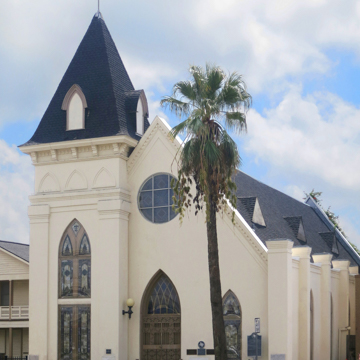Broadway, the one-hundred-fifty-foot-wide, palm tree–lined boulevard that divides Galveston's city plan into north and south halves, was the most fashionable residential street in late-nineteenth-century Galveston. Typical of nineteenth-century cities, however, Broadway was an urban street. It lacked the class consistency and visual uniformity that would be enforced in the twentieth century through zoning codes and restrictive covenants. Lying between the elite neighborhoods of central Broadway and the East End were several blocks of small, mixed-use business and residential buildings. Several African American congregations built churches in the 2000 block of Broadway. Reedy Chapel African Methodist Episcopal Church by B. G. Chisolm, an itinerant architect who also practiced in Colorado and Alabama, began as the slave congregation of the First Methodist Church and has occupied this site since 1848. The present building replaced a predecessor, destroyed in the fire of 1885. Chisolm's massing and composition are simple. Their effect is emphatic, however, because of his use of raised piers, molded bands, and stucco surfacing, which animate the church and give the small building its sense of presence.
You are here
Reedy Chapel AME Church
If SAH Archipedia has been useful to you, please consider supporting it.
SAH Archipedia tells the story of the United States through its buildings, landscapes, and cities. This freely available resource empowers the public with authoritative knowledge that deepens their understanding and appreciation of the built environment. But the Society of Architectural Historians, which created SAH Archipedia with University of Virginia Press, needs your support to maintain the high-caliber research, writing, photography, cartography, editing, design, and programming that make SAH Archipedia a trusted online resource available to all who value the history of place, heritage tourism, and learning.















